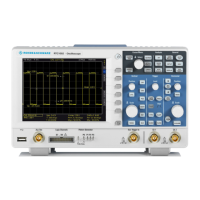Trigger
R&S
®
RTC1000
47User Manual 1335.7352.02 ─ 02
5 Trigger
Triggering means to capture the interesting part of the relevant waveforms. Choosing
the right trigger type and configuring all trigger settings correctly allows you to detect
various incidents in signals.
A trigger occurs if the trigger conditions are fulfilled. The instrument acquires continu-
ously and keeps the sample points to fill the pretrigger part of the waveform record.
When the trigger occurs, the instrument continues acquisition until the posttrigger part
of the waveform record is filled. Then it stops acquiring and displays the waveform.
When a trigger is recognized, the instrument does not accept another trigger until the
acquisition is complete.
Trigger conditions include:
●
Source of the trigger signal (channel)
●
Trigger type and its filter setup
●
Trigger mode
In addition, the trigger position and the reference point are important to display the
interesting part of the signal. See Chapter 4.2, "Horizontal Setup", on page 39.
The trigger level and position are marked in the grid. The markers have the color of the
trigger source. Information on the most important trigger settings is shown above the
grid, in the middle of the information bar.
5.1 Setting Up the Trigger
1. To activate the normal trigger mode, press the AUTO/NORM key.
A red LED highlights the key if normal mode is active.
2. To select the trigger source:
a) Press the SOURCE key.
b) Select the trigger source in the menu.
3. To configure the trigger type:
a) Press the TYPE key.
b) Select the trigger type.
c) Press the FILTER key.
d) Define the trigger condition.
4. To define the hold-off time:
a) Press the TYPE key.
b) Press the "HOLD OFF" softkey to enable the hold-off.
c) Turn the universal knob in the Cursour/Menu section to adjust the value.
Setting Up the Trigger

